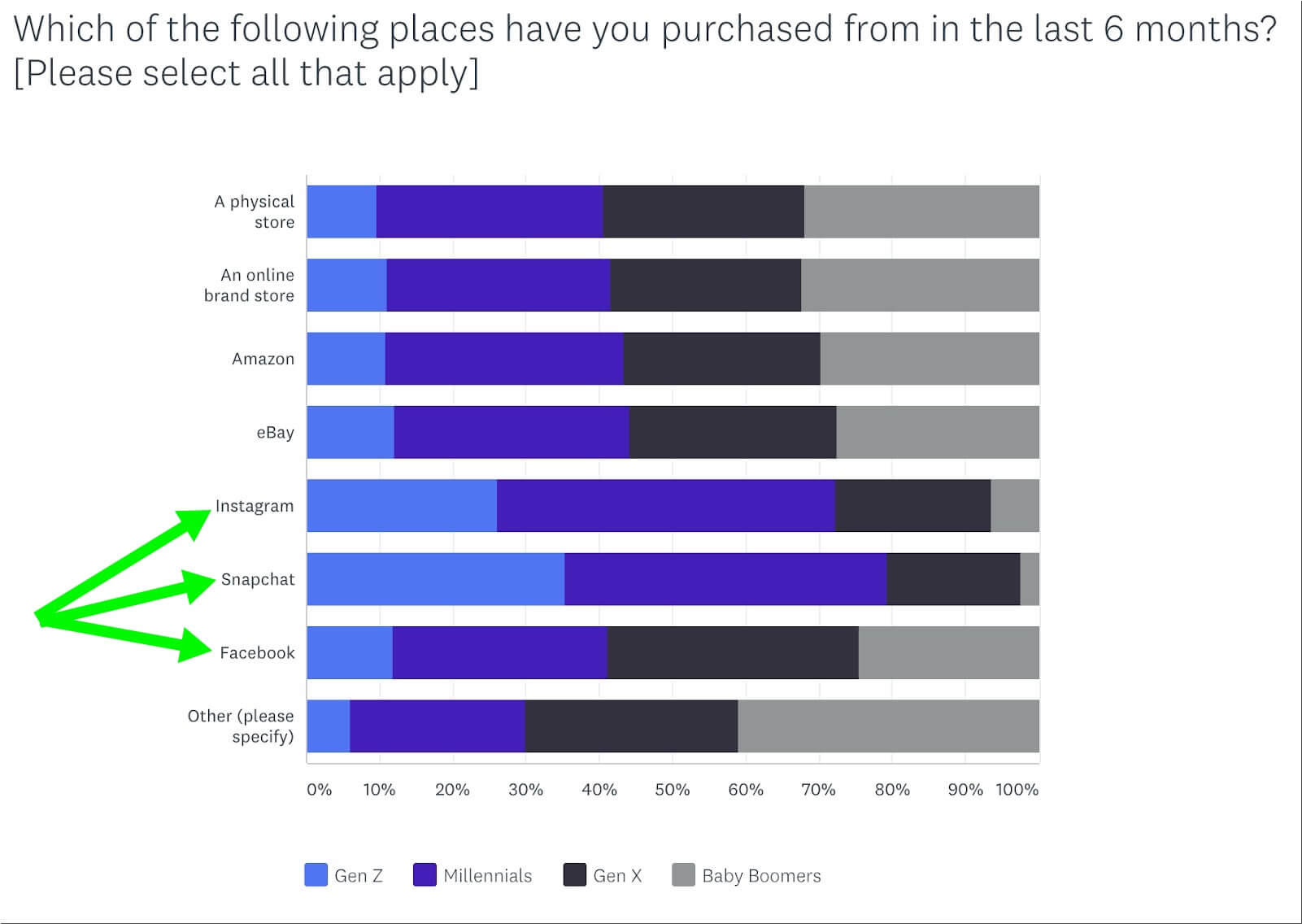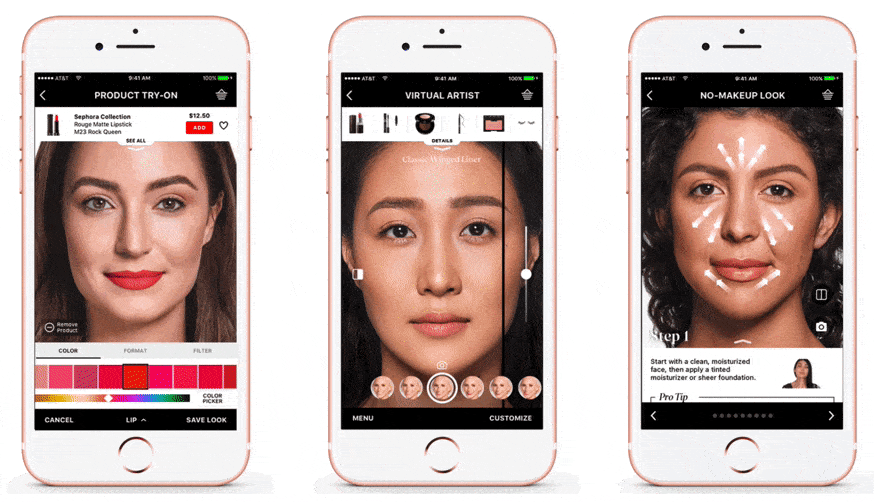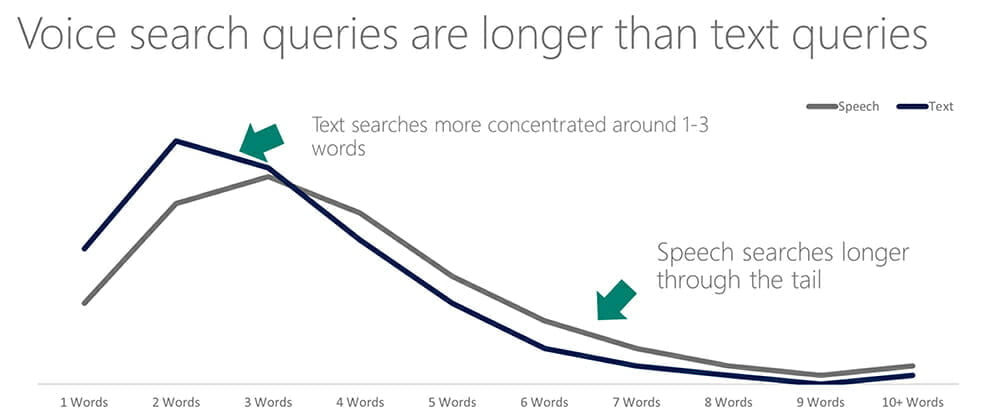The eCommerce industry continues to redefine the commercial landscape, with rapid technological advancements shaping the way brands interact with consumers. As we progress through 2023, understanding and adapting to these dynamic trends is more crucial than ever for businesses aiming to thrive in the digital marketplace.
The Top E-commerce Trends
1. Social Commerce: The New Frontier of Online Shopping
Social commerce has evolved from a burgeoning trend into a fundamental aspect of online retail. Platforms like Instagram, Facebook, TikTok, and Snapchat have transformed into comprehensive shopping channels, offering seamless purchase experiences within their ecosystems. Brands are leveraging these platforms for targeted marketing and direct sales, capitalizing on the vast user base and integrated eCommerce functionalities. Personalized advertising and shoppable posts have become key strategies in harnessing the potential of social commerce.

Both Gen Z and Millennials spend most on products they come across on social media channels, especially Snapchat and Instagram. Source: Bigcommerce omnichannel marketing report
Here are a few ways you can embrace social commerce in your business:
- Use Facebook “Shop” buttons to produce a 5 to 10% increase in revenue.
- Use product showcases on Facebook to promote seasonal offers and products
- Embrace shoppable stories on Instagram and Snapchat allowing your customers to buy from you right from your stories
2. Artificial Intelligence: Create Personalization and Improve Efficiency
Artificial Intelligence (AI) has transcended its initial role in the eCommerce sector, becoming integral to various aspects, from customer service to supply chain management. Predictive analytics powered by AI are now more sophisticated, enabling businesses to forecast consumer behavior with greater accuracy.
AI-driven chatbots and virtual assistants have advanced significantly, offering personalized shopping assistance and efficient customer service. The role of AI in personalization, including customized product suggestions and dynamic pricing, continues to be a game-changer in enhancing user experience and boosting sales.

Machine learning makes it possible to take all the scattered data from various devices and channels together to create individual customer profiles, discover patterns, and set up advanced personalized experiences. Make sure to find a personalization technology partner that is best for your brand. Luckily, we have quite a few powerful players in this sector already, including Hubspot and Moengage.
3. Enhancing the Shopping Experience with Augmented Reality and Virtual Reality
Augmented Reality (AR) and Virtual Reality (VR) are redefining the online shopping experience by providing immersive and interactive environments. AR is being widely used for virtual try-ons, from cosmetics to furniture placement, enhancing the decision-making process for customers. VR takes this a step further by offering fully immersive experiences, potentially revolutionizing online retail. These technologies are crucial for businesses seeking to bridge the gap between online and physical shopping experiences.

4. Voice and Visual Search: The Evolving Face of Online Queries
The shift towards voice and visual search is significantly impacting eCommerce. Voice-activated devices and assistants have become more prevalent, leading to an increase in voice-based shopping. This trend necessitates an optimization of eCommerce platforms for voice search compatibility. Similarly, visual search technology has advanced, allowing customers to search for products using images, which has implications for SEO strategies and the necessity of high-quality, optimized imagery on websites.
E-commerce companies have to optimize their websites to stay up-to-date because this trend is here to stay:
- Create a dynamic (adaptive/responsive) website
- Use high-quality and search-optimized photos on each product page
- Make use of Google’s structured data including Speakable
- Get your local listing in order, i.e. keep it clean and updated as most voice search users search for local-based queries.
- Optimize for plenty of well-researched, flowing long-tail keywords and phrases in your content. This includes researching niche questions on forums, tracking keyword context in real-time on Twitter, taking notes from phone calls with customers, etc

5. Accelerated Use of Mobile Shopping: The Era of On-the-Go eCommerce
In 2023, the accelerated use of mobile shopping has become a cornerstone of eCommerce. The proliferation of smartphones and improved mobile networks have made shopping on-the-go a norm rather than an exception. Consumers now expect a seamless, intuitive mobile shopping experience, from browsing to checkout. This shift has led to a significant increase in mobile-first strategies among eCommerce businesses.
Key factors driving this trend include the convenience of shopping anytime and anywhere, the rise of mobile payment solutions, and the integration of social media with mobile commerce. Businesses are focusing on optimizing their mobile websites and apps to enhance user experience, with features like one-click checkout, personalized mobile interfaces, and improved security measures.
The impact of mobile shopping is profound, influencing not only consumer behavior but also the way businesses approach marketing, customer engagement, and sales strategies. To remain competitive and relevant, eCommerce companies must prioritize mobile optimization and offer a superior mobile shopping experience that aligns with the expectations of today’s consumers.
6. Building Loyalty Through Long-Term Customer Relationships
In 2023, cultivating long-term customer relationships has emerged as a pivotal trend in eCommerce, driven by an increasingly competitive marketplace and the high cost of acquiring new customers. Establishing enduring relationships with customers is not just about repeated transactions; it’s about creating a loyal customer base that champions your brand.
Why It’s Important:
- Enhanced Customer Lifetime Value: Long-term customers typically spend more over time, increasing their lifetime value.
- Brand Advocacy: Satisfied, loyal customers often become brand advocates, recommending your products or services to others.
- Feedback and Improvement: Regular customers provide valuable feedback, helping you refine your offerings and customer experience.
Tips for Establishing Long-Term Customer Relationships:
- Personalized Experiences: Use customer data to provide personalized shopping experiences. Tailored product recommendations, personalized emails, and targeted promotions make customers feel valued and understood.
- Exceptional Customer Service: Prioritize quick, efficient, and empathetic customer service. Offering multiple channels for support, including live chat and social media, and ensuring quick resolution of issues can build trust and loyalty.
- Loyalty Programs: Implement loyalty programs that reward repeat purchases and engage customers. Points systems, exclusive deals for returning customers, and special birthday or anniversary offers can encourage repeat business.
- Quality Products and Services: Consistently high-quality offerings are the foundation of long-term customer relationships. Ensure your products or services meet and exceed customer expectations.
- Regular Communication: Keep in touch with your customers through regular, meaningful communication. Newsletters, product updates, and helpful content can keep your brand top of mind.
- Customer Feedback Loop: Encourage and act on customer feedback. Showing customers that their opinions are valued and can lead to tangible changes fosters a sense of ownership and loyalty.
- Community Building: Create a community around your brand. Engage with customers on social media, forums, or through events. Building a community helps customers feel a part of something larger than just a transaction.
Building long-term customer relationships in the modern eCommerce environment requires a multi-faceted approach, focusing on personalization, quality, engagement, and excellent service. These relationships are vital not only for sustained revenue but also for building a robust, loyal customer base that can become a significant asset for any eCommerce brand.
7. Programmatic Advertising: Simplifying and Amplifying Digital Marketing
In 2023, programmatic advertising stands as a revolutionary force in digital marketing. It’s an automated approach to buying and selling online ad space, utilizing advanced technologies like artificial intelligence (AI) and real-time bidding (RTB). This trend significantly simplifies the advertising process while amplifying its effectiveness for businesses of all sizes.
Simplified Explanation: Programmatic advertising automates the ad-buying process, where software is used to purchase digital advertising. Unlike traditional methods that involve manual negotiations and preparation, programmatic advertising uses machines and algorithms to buy display space. When a user clicks on a webpage, an automated auction takes place where advertisers bid for the ad impression in real time. The winner’s ad is then instantly displayed to the user. This entire process is efficient, fast, and happens in milliseconds.
Benefits for Businesses:
- Efficiency and Time-Saving: Automation streamlines the ad buying process, saving time and reducing the need for extensive manual work. This efficiency allows businesses to focus more on strategy and creative aspects of advertising.
- Targeted Advertising: With programmatic advertising, businesses can target specific audiences based on data like user behavior, demographics, interests, and more. This precise targeting means ads are more relevant to the audience, increasing the likelihood of engagement.
- Cost-Effectiveness: Real-time bidding allows businesses to control their ad spending effectively. They can set maximum bids and budgets, ensuring they get the best value for their ad spend.
- Increased Reach and Scalability: Programmatic advertising provides access to a wide range of ad spaces across the internet, including websites, mobile apps, and video platforms. This increased reach means businesses can scale their advertising efforts quickly and efficiently.
- Data-Driven Insights: By leveraging AI and machine learning, programmatic advertising offers valuable insights based on ad performance data. Businesses can use these insights to optimize their campaigns for better results continuously.
- Improved ROI: With its targeted approach and efficient use of ad budgets, programmatic advertising can significantly improve the return on investment for marketing campaigns.
Incorporating programmatic advertising into a business’s digital marketing strategy can lead to more efficient, cost-effective, and impactful advertising. By leveraging this technology, businesses can ensure that their ads are reaching the right audience at the right time, thereby enhancing their overall marketing effectiveness and contributing positively to the bottom line.
8. The Rise of Short-Form Video: Captivating Audiences in Seconds
Short-form video has emerged as a dominant trend in digital marketing, particularly in the eCommerce sector. This format, typically spanning from a few seconds to a couple of minutes, has become a powerful tool for engaging and captivating audiences quickly and effectively.
The Power of Short-Form Video:
- Instant Engagement: In an era of short attention spans, short-form videos can capture and hold the viewer’s attention immediately.
- Shareability: Due to their concise and impactful nature, these videos are more likely to be shared across social platforms, increasing brand visibility.
- Versatility: Short-form videos are versatile and can be used for a variety of purposes, from product showcases and customer testimonials to behind-the-scenes glimpses and brand storytelling.
Final Thoughts
As we delve deeper into 2023, these four trends are not just shaping the future of eCommerce; they are actively defining it. Embracing social commerce, leveraging AI for enhanced personalization, integrating AR and VR for immersive experiences, and adapting to the rise of voice and visual search are no longer options but necessities for businesses aiming to succeed in the ever-evolving digital marketplace. E-commerce players need to continuously innovate and adapt to these trends to stay competitive and relevant in this dynamic industry.



















